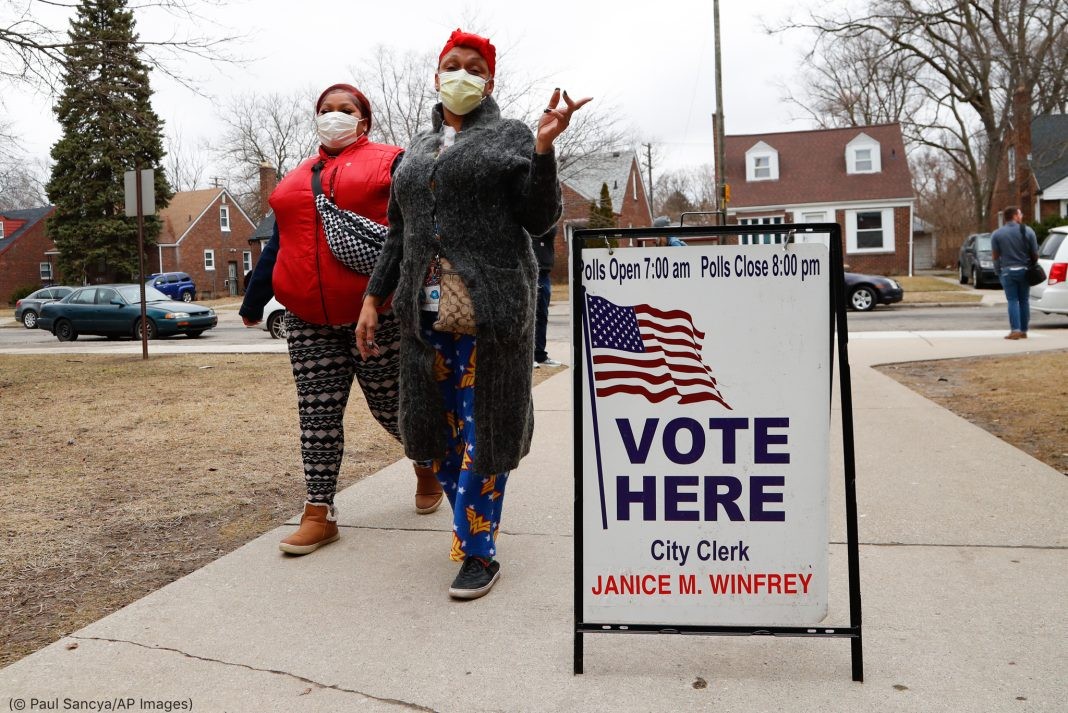Swing states, often referred to as battleground states or toss-up states, are the linchpin of United States presidential elections. Unlike states with predictably partisan voting patterns, swing states are characterized by their political ambivalence, making them fiercely contested ground in every election cycle. These are the states where the presidential race is often decided, capturing the lion’s share of campaign attention, resources, and strategic maneuvering.
 Voters in masks at Bow Elementary School, Detroit, Michigan, a swing state, during the state primary election.
Voters in masks at Bow Elementary School, Detroit, Michigan, a swing state, during the state primary election.
Defining Swing States: Where Elections are Won and Lost
A swing state is defined by its history of oscillating between support for Democratic and Republican candidates. These states do not consistently vote for one party, making their outcomes uncertain and highly influential. The political demographics within these states are often closely divided, reflecting a diverse electorate that is not easily categorized into firm partisan camps. This inherent unpredictability forces candidates to actively campaign and persuade voters, rather than relying on assumed party loyalty.
Experts frequently cite a core group of states that consistently fall into the swing state category, although the exact list can vary slightly depending on the election cycle and evolving political landscapes. The Cook Political Report, a highly respected non-partisan election forecaster, identifies Arizona, Florida, Michigan, Pennsylvania, and Wisconsin as consistently being toss-up states. Other analysts often include states like New Hampshire, North Carolina, Nevada, and sometimes even Georgia or Ohio, depending on the specific election context and prevailing political winds.
The Decisive Impact on the Electoral College
The significance of swing states is inextricably linked to the U.S. Electoral College system. In this system, Americans do not directly elect the president by popular vote. Instead, they vote for a slate of electors who then cast the actual votes for president. Each state is allocated a number of electors equal to its total number of representatives in Congress (House + Senate). In almost all states, the candidate who wins the popular vote in that state receives all of its electoral votes – a winner-take-all system.
Swing states become crucial because they offer the most efficient path to accumulating the 270 electoral votes needed to win the presidency. Candidates focus their resources on these states because even small shifts in voter preference can translate into significant gains in electoral votes. For instance, Florida, a perennial swing state, boasts a substantial 29 electoral votes, tying it with New York for the third-largest bloc after California and Texas. Winning Florida, therefore, represents a major step towards securing the presidency. The concentration of campaign efforts on swing states underscores their outsized influence in determining the outcome of presidential elections.
Examples of Key Swing States and Their Unique Characteristics
Several states are consistently identified as pivotal swing states due to their demographic diversity and fluctuating voting patterns.
-
Florida: As highlighted in the original article, Florida is perhaps the quintessential swing state. Its large and diverse population includes significant blocs of elderly voters, young independents, and diverse ethnic groups, including Cuban-Americans and Puerto Ricans, who exhibit varying political leanings. Florida’s history of close elections and its tendency to swing between parties, supporting both Barack Obama and George W. Bush in recent elections, solidify its swing state status.
-
Pennsylvania, Michigan, and Wisconsin: These Midwestern states, sometimes referred to as the “Rust Belt,” have become increasingly important swing states in recent elections. Once reliably Democratic, these states have seen shifts in voter sentiment, particularly among working-class voters. Economic anxieties and demographic changes have made them battlegrounds where both parties see opportunities for victory.
-
Arizona and Nevada: These Southwestern states are rapidly evolving demographically, with growing Latino populations and an influx of new residents. This demographic shift has made them more competitive, moving them from reliably Republican states to swing state status. Issues such as immigration, water rights, and the economy play prominently in these states.
-
North Carolina and Georgia: These Southern states are also trending towards swing state status due to urbanization and demographic changes. While traditionally Republican strongholds, increasing diversity and the growth of urban centers are making them more politically competitive, particularly in presidential elections.
Why Swing States Dominate Campaign Strategies
Presidential campaigns prioritize swing states because winning these states is the most direct route to the White House. Campaign resources, including candidate visits, advertising spending, and ground operations, are disproportionately allocated to these key battlegrounds. Candidates tailor their messages to resonate with the specific concerns and demographics of voters in each swing state.
This focus on swing states can lead to criticism that candidates neglect voters in states considered safely Democratic or Republican. However, from a strategic perspective, campaigns must maximize their resources where they can have the greatest impact, and swing states, by definition, are where voter preferences are most malleable and election outcomes are most uncertain.
Understanding swing states is crucial to understanding the dynamics of U.S. presidential elections. These politically divided states are the arenas where campaigns are fought most intensely, and their voters ultimately play a decisive role in choosing the next president of the United States.